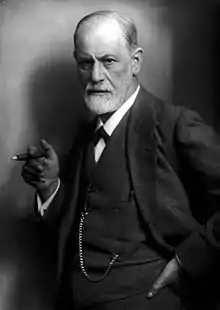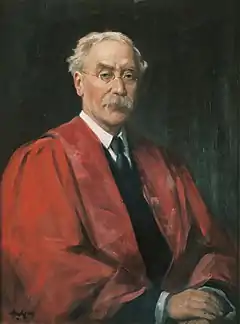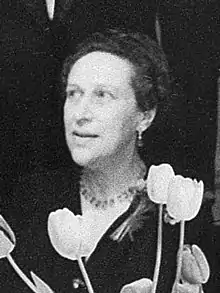| Predecessor | London Psychoanalytical Society |
|---|---|
| Formation | 1913 |
| Founder | Ernest Jones |
| Merger of | Institute of Psychoanalysis |
| Location |
|
| Leader | Vic Sedlak (President) |
| Website | http://psychoanalysis.org.uk/ |
| Part of a series of articles on |
| Psychoanalysis |
|---|
.jpeg.webp) |
The British Psychoanalytical Society was founded by Ernest Jones as the London Psychoanalytical Society on 30 October 1913. It is one of two organisations in Britain training psychoanalysts, the other being the British Psychoanalytic Association.
The society has been home to a number of psychoanalysts, including Wilfred Bion, Donald Winnicott, Anna Freud and Melanie Klein. Today it has over 400 members and is a member organisation of the International Psychoanalytical Association.[1]
Establishment and name
Psychoanalysis was founded by Sigmund Freud, and much of the early work on Psychoanalysis was carried out in Freud's home city of Vienna and in central europe. However, in the early 1900's Freud began to spread his theories throughout the English speaking world. Around this time he established a relationship with Ernest Jones, a British neurosurgeon who had read his work in German and met Freud at the inaugural Psychoanalytical Congress in Salzburg. Jones went on to take up a teaching post at the University of Toronto, in which capacity he established the American Psychoanalytic Association.

When Jones returned to London, he established the society in 1913, as the London Psychoanalytical Society. The society had 9 founding members including William Mackenzie, Maurice Nicoll and David Eder.[2] Almost immediately, the society was caught up in the international controversy between Carl Jung and Sigmund Freud. Many of the society's membership were followers of Jung's theories, although Jones himself enjoyed a close relationship with Freud and wished for the society to be unambiguously Freudian.[3] Jones had joined Freud's Inner circle in 1912, and helped to oust Jung from the International Psychoanalytical Association.
However, the outbreak of World War One in 1914 meant that the nascent society, which depended heavily on correspondence with psychoanalysts in Vienna, then part of Austria-Hungary, had to be suspended. There were a few informal meetings during the war, but these became less and less frequent as the war went on.
In 1919, Ernest Jones re-founded the society as the British Psychoanalytical Society, and served as its President. He took the opportunity to define the society as Freudian in nature, and removed most of the Jungian members. With the help of John Rickman, the society established a clinic and a training arm, known as the Institute of Psychoanalysis.[4]
Interwar years

In the 1920s, Ernest Jones and the society grew increasingly under the influence of Melanie Klein. Jones was inspired by her writings to develop several of his own psychoanalytical concepts. In 1925, Klein delivered a series of talks at the society on her theories.[5] Klein's work was well received in London, but it attracted increasing controversy on the continent, where the majority of psychoanalysts were still based. Realising that her ideas were not warmly received at the Berlin Psychoanalytic Institute, where Klein was based, Jones invited her to move to London, which she did later in 1925.
The rise of the Nazi Party in Germany and later in Austria, led to increasing numbers of German and Austrian Psychoanalysts fleeing to London, where they joined the burgeoning society. By 1937, 13 out of 71 members were refugees from Europe.[3] Ernest Jones personally intervened to bring Sigmund Freud and his daughter, Anna Freud, to London.[2] In 1938, Sigmund Freud wrote to Jones:
"The events of recent years have made London the principal site and center of the psychoanalytical movement. May the society carry out the functions thus falling to it in the most brilliant manner."[6]
By the start of the second world war, 34 out of 90 members were emigres from the continent. Among them were:
| Analyst | Previous membership | First year of BPAS membership | Year of leaving |
|---|---|---|---|
| Anna Freud | Vienna Psychoanalytical Society | 1938 | Remained a member until death. |
| Dorothy Burlingham | Vienna Psychoanalytical Society | 1938 | Remained a member until death. |
| Erwin Stengel | Vienna Psychoanalytical Society | 1938 | Remained a member until death. |
| Eduard Hitschmann | Vienna Psychoanalytical Society | 1938 | 1940 – For Harvard Medical School |
| Otto Isakower | Vienna Psychoanalytical Society | 1938 | 1940 – Emigrated to New York City |
| Grete L. Bibring | Vienna Psychoanalytical Society | 1938 | 1941 – For Tufts University |
| Ernst Kris | Vienna Psychoanalytical Society | 1938 | 1940 – Emigrated to New York City |
| Kate Friedlander | Berlin Psychoanalytic Institute | 1933 | Remained a member until death. |
| Paula Heimann | Berlin Psychoanalytic Institute | 1938 | Remained a member until death. |
| Michael Balint | Hungarian Psychoanalytic Society | 1945 (though he moved to the UK with the help of Ernest Jones in 1938) | Remained a member until death. |
| Melitta Schmideberg | Berlin Psychoanalytic Institute | 1933 | 1944 – Resigned due to outcome of the Controversial discussions. |
| Eva Rosenfeld | Vienna Psychoanalytical Society | 1936 | Remained a member until death. |
However, the assimilation of so many prominent Psychoanalysts from continental Europe created tensions. The huge difference in the approaches of Anna Freud and Melanie Klein led to the development of several factions. Increasingly, presentations of papers at the society became thinly veiled attacks on opposing factions theories. For example, in March 1937 Melitta Schmideberg (Klein's daughter) presented her paper: "After the Analysis – Some Phantasies of Patients", which viciously attacked almost all of Klein's ideas, though it did not mention her by name.[7][8]
The views of the different Psychoanalysts: Kleinian, Freudian, and those who were not affiliated with either, led to increasing dysfunction, and things became so bad that a specific committee had to be established to deal with the problem.
The 'controversial discussions'

By 1942, relations between the factions within the society had become so heated that a committee had to be convened to facilitate monthly discussions on the scientific nature of the society.[9] The committee was chaired by three members of the society, each representing one of the major factions:
- James Strachey – a member of the British Independent Group.
- Marjorie Brierley – an ally of Melanie Klein.
- Edward Glover – who identified as 'pure Freudian', in opposition to Melanie Klein. Glover resigned from the society in 1944, along with several other Freudian psychoanalysts.
After heated debate, the committee resolved to a "gentleman's agreement" – which ensured that each faction would have equal representation within all committees within the society. It was also agreed that training of future psychoanalysts at the institute would be organised into two pathways: one Kleinian, and one Freudian.
After World War Two
With the resolution of the controversial discussions, the society became dominated by independent psychoanalysts such as Donald Winnicott, Michael Balint or Wilfred Bion.
Prominent members of the society and Institute
 William Leslie Mackenzie, a founding member of the Society.
William Leslie Mackenzie, a founding member of the Society.



Prominent members of the Society include:
- Michael Balint
- Wilfred Bion – A member from 1950.[10]
- Marjorie Brierley – A member from 1930 until her death.[11]
- David Eder
- Rose Edgcumbe
- Ronald Fairbairn
- Anna Freud
- André Green
- Stephen Grosz
- Betty Joseph
- Melanie Klein – A member for over 30 years.[12]
- William Leslie Mackenzie
- Tom Main
- Donald Meltzer – A member from the mid-1950s to the early 1980s[13]
- Maurice Nicoll
- Lionel Penrose
- Rosine Perelberg – Current President of the society
- John Rickman
- Joan Riviere
- Charles Rycroft
- Ella Sharpe – Became a member in 1921.[14]
- Donald Winnicott – President of the society twice: 1954–56 and 1963–65.[15]
The society today
Through its related bodies, the Institute of Psychoanalysis and the London Clinic of Psychoanalysis, it is involved in the teaching, development, and practice of psychoanalysis at its headquarters at Byron House, west London. It is a constituent organisation of the International Psychoanalytical Association and a member institution of the British Psychoanalytic Council.
References
- ↑ "Who we are | Institute of Psychoanalysis". psychoanalysis.org.uk. Retrieved 26 October 2020.
- 1 2 "100 years of history | Institute of Psychoanalysis". psychoanalysis.org.uk. Retrieved 10 October 2018.
- 1 2 Robinson, Ken (2015). A Brief History of The British Psychoanalytical Society. Institute of Psychoanalysis. pp. 1–3.
- ↑ "Ernest Jones | Institute of Psychoanalysis". www.psychoanalysis.org.uk. Retrieved 3 November 2018.
- ↑ "Melanie Klein | Institute of Psychoanalysis". www.psychoanalysis.org.uk. Retrieved 3 November 2018.
- ↑ Freud, Sigmund (1992). Letters of Sigmund Freud. Freud, Ernst L., 1892–1970. New York: Dover. ISBN 0486271056. OCLC 24794598.
- ↑ "melanie klein trust". www.melanie-klein-trust.org.uk. Retrieved 3 November 2018.
- ↑ Schmideberg, Melitta. "After the Analysis" (PDF). Journal of the Centre for Freudian Analysis and Research. Retrieved 3 November 2018.
- ↑ "Announcement of the 'Controversial Discussions' | Institute of Psychoanalysis". psychoanalysis.org.uk. Retrieved 3 November 2018.
- ↑ "Wilfred Bion | Institute of Psychoanalysis". psychoanalysis.org.uk. Retrieved 10 October 2018.
- ↑ "Marjorie Brierley | Institute of Psychoanalysis". psychoanalysis.org.uk. Retrieved 10 October 2018.
- ↑ "Melanie Klein | Institute of Psychoanalysis". psychoanalysis.org.uk. Retrieved 10 October 2018.
- ↑ "Donald Meltzer | Institute of Psychoanalysis". psychoanalysis.org.uk. Retrieved 10 October 2018.
- ↑ "Ella Sharpe | Institute of Psychoanalysis".
- ↑ "Donald Woods Winnicott | Institute of Psychoanalysis". psychoanalysis.org.uk. Retrieved 10 October 2018.